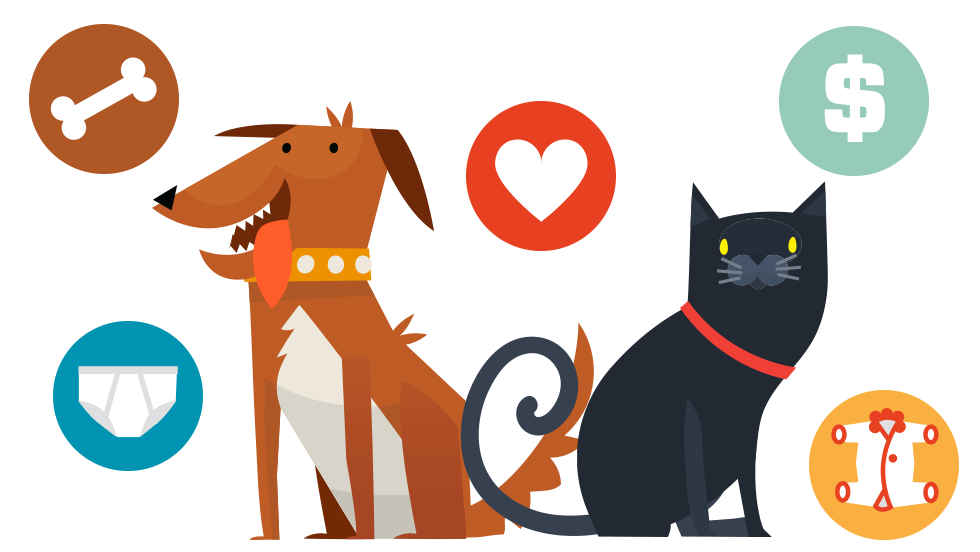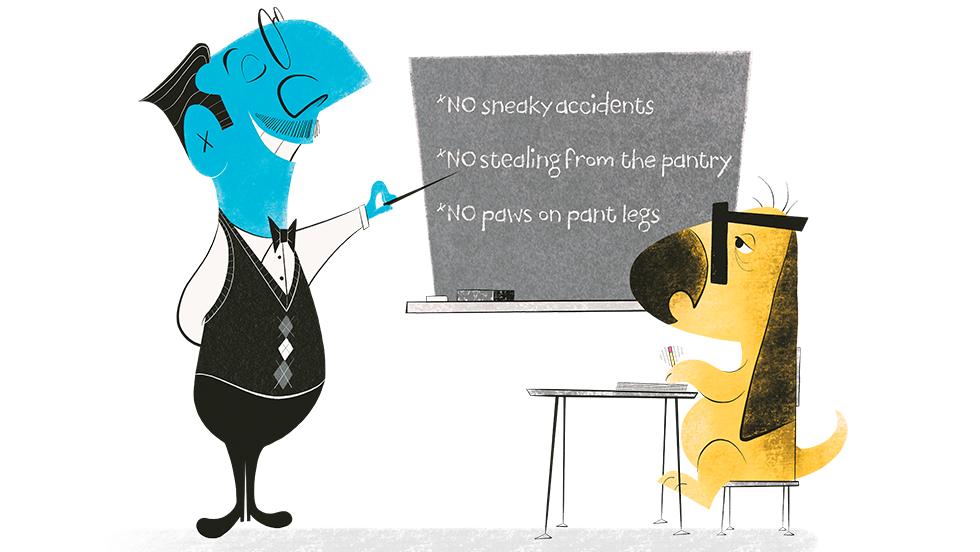Pets of Gambier: A Photo Essay
Drama cats. Presidential dogs. A flock of peacocks. Meet some of Kenyon's most beloved residents.
Read The StorySix alumni who work with animals share their favorite tips, tales and tricks of the trade.
Story by Liz Logan
Perhaps it was all of those warm spring days spent wandering through the pine grove at the Brown Family Environmental Center, the hours volunteering with livestock at nearby farms, or a particularly moving class lecture on animal cognition. Wherever that initial spark of inspiration began, a number of Kenyon alumni who love animals have found creative and unexpected careers in which they engage with the animal world. Whether it’s nursing a baby penguin in a zoo or spending a Saturday shearing sheep as a side job, these folks are making life better for all creatures, great and small.
We asked six alumni to share their favorite tips, tricks and stories from their work with animals.
Calli Towne ’90 is the training coordinator at the Massachusetts Society for the Prevention of Cruelty to Animals at Nevins Farm, the only open-door farm animal and horse rescue center in New England. Towne started at Nevins in 1998 as an animal caregiver and, in 2004, she started a dog training program, which now hosts classes every day of the week. Here are the most common issues that dog owners approach Towne about — and her advice.
“I don't want my dog to jump on people.”
Training should focus on what you want the dog to do, not what you don’t want them to do. Have your dog on a leash and have a stash of treats handy. Ask a family member to approach the dog. If the dog is sitting or even just standing with all four feet on the floor, they get a treat. If the dog gets up or moves to jump up, the person should immediately turn away from the dog, walk out of range and stay there until the dog settles back down. Have the person repeat this approach at least 10 times before you switch to a new person. Gradually work up to approaches from people who are less familiar. You can also limit the behavior by using a leash under foot to keep the dog from jumping. Another trick is to have a toy in the dog’s mouth, which often can keep a dog from jumping.
“My 6-month-old puppy sneaks away to where I can’t see him and then has an accident.”
This problem needs a two-pronged approach. First, many puppies have too much freedom in the house. Limit your dog’s access to the areas where these “accidents” occur by putting up baby gates, or use the dog’s crate, a drag leash or a tether to limit him. Second, and more important, reward the dog when he goes to the bathroom outside.
“My dog barks and lunges when he sees other dogs.”
One way to help a reactive dog is to use classical conditioning. You want to pair seeing the thing the dog is afraid of with something positive, like a treat. But fear in dogs can be a complicated issue. If the dog is growling or biting, seek out a behavioral expert.
Taylor Woods ’11 is an avian nursery keeper at the Dallas World Aquarium and formerly was a member of the animal care staff at the Oregon Zoo, in Portland, where she cared from animals ranging from birds and butterflies to rhinos and primates. Growing up in Eugene, Oregon, she had cats, hamsters and fish, and she went to horse camp in the summer. When she was at Kenyon, majoring in modern languages and literatures, she didn’t realize that being a zookeeper could be a career. That world opened up to her after Kenyon, when she started volunteering at the Oregon Zoo while working at an entry-level job at a law firm.
Zoos have faced particular scrutiny in the past year, since a silverback gorilla was shot at the Cincinnati Zoo in May 2016, after a child fell into its enclosure. We asked Woods to discuss common misconceptions about zoos.
What makes a “good” zoo?
That’s a great question, because not all of them are high-quality. Zoos that are accredited by the independent, nonprofit Association of Zoos and Aquariums are held to a much higher standard. They provide excellent care for the animals and high-quality educational experiences for visitors and are engaged in conservation efforts.
What are some common criticisms of zoos?
One of the biggest complaints is that zoos can’t possibly provide as much space as the animals would use in the wild. This is true; however, most animals only travel large distances to find food or shelter. Since zoos provide them with a safe habitat and we regularly — daily, in most cases — feed the animals, there is no need for them to have miles and miles of space. Another complaint is that we train our animals to do “tricks,” when, in fact, we teach our animals different behaviors in order to make it easier to check them for illness and injuries. To look at a tiger’s belly, you can wait for him to lie down, or you can train him to stand on his hind legs. This “operant conditioning” is used all the time in zoos, because it helps us quickly identify and treat illnesses and injuries. It also provides enrichment for the animals.
What are some examples of conservation efforts at zoos?
The main goals of zoos are education and conservation. These institutions also take part in a lot of research that would be difficult, if not impossible, to do on wild animals, and often they raise money for conservation efforts around the world. Then, there are species that were on the endangered species list that were repopulated by zoos, including California condors, red wolves and black-footed ferrets. I work with California condors, which are the largest birds in North America, with a 10-foot wing span. They were listed as an endangered species and at one point there were only 22 of these birds in the wild. The Oregon Zoo helped with the effort to recover these birds, breed them and then carefully reintroduce them back into the wild. Now there are 200 of these birds flying free.
In your opinion, what is the most worthwhile aspect of zoos?
So many animals are threatened, vulnerable or endangered, such as the Asian elephants, orangutans and Humboldt penguins that I work with. I didn’t start working in zoos because I love having animals in captivity — certainly not. But zoos provide good lives for the animals and they are a kind of insurance against extinction. That’s really important, at least until humans do a better job of protecting animals in the wild.
Katie Jackson Cannon ’04 spends her days working as the curator of education at the Daughters of the American Revolution Museum in Washington, D.C., and moonlights on the weekends as a sheep shearer. Cannon became fond of sheep after many years of working around livestock at living history museums, including Indiana’s Conner Prairie Interactive History Park and George Washington’s Mount Vernon in Virginia. She didn’t realize, however, just how difficult these woolly animals can be. She describes the sheep shearing process — which involves tipping the sheep onto its hindquarters, bending over it, and then constantly shifting the sheep and her own body —as “giving a haircut to a 200-pound screaming toddler.”
30 Number of minutes it took Katie to shear her first sheep.
5 Number of minutes it takes Katie to shear a sheep now.
100 Number of sheep Katie sheared before she “felt comfortable,” getting all the wool off mostly in one piece and leaving each sheep relatively smooth.
$500 The cost of Katie’s electric shearing kit (previously, she used hand shears, which look like big scissors).
1 Number of rabbits Katie shears regularly — Tilion, her French Angora,
9 Number of years Katie has been married to Brian Cannon ’05, an animal keeper at the Smithsonian National Zoo, with whom she shares three cats, two ferrets and two rabbits.
Veterinarian Jeffrey Booth ’92 is a partner at Brenford Animal Hospital in Dover, Delaware. His work with cats and dogs includes medical visits, surgery, radiology and ultrasonography. In the 1990s, he served in the U.S. Army Vet Corps, where he treated military dogs and Secret Service dogs. We chatted with him about his background, as well as the most pressing health issues that pets face today.
How was your work with the U.S. Army Vet Corps different from what you do today?
Now, with pets, I do a lot of surgeries and emergency care, whereas military and Secret Service dogs are generally very healthy. Each Secret Service agent gets assigned one dog for their entire career, so they take excellent care of their dogs. The military dogs I saw were trained first to protect service members, and then also to sniff for bombs or drugs. Because they’re trained to attack in certain situations, the dogs could be very intense. I heard a story of one who broke through the windshield of a police car. I also heard interesting stories about where the dogs and their handlers, who were often 18- or 19-year-olds, had been: the Middle East, Bosnia and other places around the world, where they would scan for bombs before the president arrived to give a speech, for instance. It was nice, because I felt like I was helping the country.
How often should I give my dog or cat treats? What about table scraps?
Treats should only be given sparingly, a few times a week at most. Table scraps — never!
What are the most common mistakes that first-time pet owners make?
First, they don’t realize the financial commitment. Second, they do not have enough time to spend with the pet, which results in behavior or training problems. Finally, they spend big bucks on “designer dogs” that are really just glorified mutts. There are plenty of mutts at the shelter who would love a new home and do not cost $500 to $1,000.
What’s the strangest diagnosis you’ve ever made?
We routinely find weird things in dogs’ guts. Underwear is a favorite of most dogs, and we’ve also seen feminine hygiene products, condoms and batteries. I once worked on a pit-bull that had a stomach stuffed full of drywall. I have seen cats swallow threaded needles and pass the needle all the way through their GI tract with the thread still attached — with no problems! But then, oddly, I’ve seen cats swallow strings and get very sick if the string gets caught somewhere in the GI tract.
Which conditions are most difficult to diagnose in dogs and cats?
There are many, but the first thing that comes to mind in cats is heart disease, because they don’t show symptoms like dogs do, and it’s not easily detected in a routine exam. Viral or fungal diseases can be hard to detect in both dogs and cats.
Increasingly, people treat their animals less like pets and more like children. How has this trend impacted your work?
The pet-human bond has always been strong, but more recently it has, indeed, become more acceptable to treat your pet like a child. So, some people are willing to spend a lot more money on their pets, which ultimately allows us to provide more advanced treatments, like specialized surgical procedures and oncology. With more money being invested in pets, we can also treat things that weren’t treated in the past: allergies, genetic orthopedic problems, even reproductive difficulties.



Jeff Dorson ’80 is the executive director of the Humane Society of Louisiana, which he founded in 1988. He’s also a licensed private investigator and one of Louisiana’s leading animal cruelty investigators. For more than a decade, he’s worked with law enforcement to expose dog fighting rings throughout the state and prosecute dog-fighters (the Bulletin profiled Dorson in its Spring/Summer 2007 issue). His organization also operates two no-kill sanctuaries — one for dogs and cats, another for horses — and transports 1,000 animals each year to the East Coast and Midwest for adoption. Dorson offered these tips for fighting animal cruelty.
Support animal charities.
“Check out your local no- or low-kill shelter and see how you can get involved, whether it’s becoming a dues-paying member, volunteering, fostering or providing supplies and other resources,” Dorson said. A number of organizations throughout the country are doing excellent work to benefit animals, he said, such as Brother Wolf Animal Rescue in Asheville, North Carolina.
Report animal cruelty if you see it.
“Identifying animal cruelty is as simple as exercising common sense. Does the animal look healthy and happy? Is it a normal weight? Is there food, water and shelter? Is it on a chain? If you notice any red flags, call your local animal control or humane society.”
Start your own rescue or humane society.
“One reason law enforcement doesn’t pursue animal abuse cases is that they don’t have the budget or the resources to pick up the animals and house them. If you’re interested in starting a rescue, call me (888-6-HUMANE). I’ll walk you through the steps.”
As a child growing up in Toledo, Ohio, Annie Valuska ’06 spent her summers freeing toads that had gotten stuck in the window wells around the basement of her family’s house.
“I would make daily patrols,” she recalled. She was interested in working with animals, but she thought the only career options were zookeeper or veterinarian — neither of which appealed to her. When she arrived at Kenyon and met Professor of Biology Bob Mauck, all of that changed. “When he introduced himself as an animal behaviorist, it blew my mind,” she said. “I went on to take many of his classes and spent summers doing fieldwork with him.”
In her scientific work, Valuska has never worked with the same species twice: At Kenyon, she did research on rats; when she earned her Ph.D. in animal behavior at the University of California, Davis, she worked with rabbits; then, as a postdoc, she studied exotic animals at Disney’s Animal Kingdom Theme Park in Orlando, Florida.
Now, as a feeding behavior scientist at Nestlé Purina North America in St. Joseph, Missouri, Valuska spends her days developing scientific studies of the cats and dogs at Purina’s pet facility, to see how they respond to, and hopefully benefit from, new food products. Once the data from a study comes in, Valuska creates a report of her findings to share with departments throughout the company, and sometimes she presents her findings at industry conferences and events, such as CatCon. “My role is to be the voice of the pet,” she said. “I love that the research I’m doing ultimately has an impact on the food that ends up on a shelf, and therefore reaches millions of animals.”
At CatCon in Los Angeles, Valuska gave a presentation on healthy eating and drinking behaviors in cats. Among the tips she shared:
Wet food should definitely be a part of your cat’s diet because cats evolved to absorb most of the water they need from eating prey. Look for wet food that’s made with real beef, poultry or fish.
Your cat's skin can be a good indicator of their health. If cats have dry, flaky skin, that means they are probably not getting enough hydration.
Running water appeals to cats, perhaps because it’s more like streams and rivers they’d find in the wild. So, consider investing in a cat drinking fountain that keeps water moving.
Drama cats. Presidential dogs. A flock of peacocks. Meet some of Kenyon's most beloved residents.
Read The StoryA conversation between Laura Hillenbrand '89 H'03 and Julie Barton '95.
Read The StoryEnglish professor (and dog lover) Jim Carson probes the significance of animals in literature, drawing on insights…
Read The Story